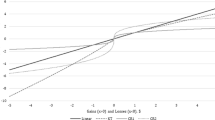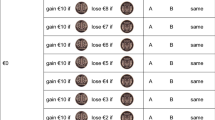Abstract
We present a new theory of decision under uncertainty: third-generation prospect theory (PT3). This retains the predictive power of previous versions of prospect theory, but extends that theory by allowing reference points to be uncertain while decision weights are specified in a rank-dependent way. We show that PT3 preferences respect a state-conditional form of stochastic dominance. The theory predicts the observed tendency for willingness-to-accept valuations of lotteries to be greater than willingness-to-pay valuations. When PT3 is made operational by using simple functional forms with parameter values derived from existing experimental evidence, it predicts observed patterns of the preference reversal phenomenon.





Similar content being viewed by others
Notes
Some descriptive limitations of prospect theory are discussed by Birnbaum and Bahara (2007).
In Bar-Hillel and Neter’s ‘Experiment 2’, subjects are unwilling to exchange lottery tickets even if they know that the number of the winning ticket will not be announced. This suggests that subjects use a state-contingent conceptualisation of gains and losses even if they will never know which state is realised.
The restriction v(f[s i ], h[s i ]) = u(f[s i ] − h[s i ]) prevents cumulative prospect theory from taking account of income effects. Kahneman and Tversky (1979, pp. 277–278) comment that ‘strictly speaking’, value should be defined as a function in two arguments—changes in wealth relative to a current asset position, and that position itself. The simpler function they use is presented as ‘a satisfactory approximation’.
Notice that the derivation of this result uses two symmetries between the treatments of gains and losses that are specific to our parameterisation: the weighting function is the same for gains and losses, and the exponent of u(.) is the same for gains and losses.
Our analysis of PR does not depend on the cumulative transformation of probabilities. The acts that we analyse have no more than one strictly positive consequence and no more than one strictly negative one. For such acts, the cumulative transformation is observationally equivalent to Handa’s simple transformation.
In addition, f P ~ h f $ ⇔ w(p) / w(q) = (pr / q)a. From now on, to avoid cluttering the exposition, we will not state conditions for indifference explicitly. In all cases, the condition for indifference can be constructed from the condition for weak preference by substituting an equality for a weak inequality.
The reader may wonder why, in all the cases represented in Fig. 2, the valuation boundary intersects the choice boundary at λ = 1. It can be shown that this property is induced by a special feature of the benchmark case, namely that the P and $ bets are symmetrical in the sense that q = 1 – p. If the bets are symmetrical and if β = 1, the valuation boundary passes through the point (ln[p / q] / ln[rp / q], 1). Whether the bets are symmetrical or not, this point lies on the choice boundary. (Since this result has little substantive significance, we leave the proof to sufficiently curious readers.) If the assumption of symmetry is relaxed, the two boundaries may intersect at positive or negative values of λ. If r > 1 and if the intersection is at a positive value of λ, there is a (typically small) region of the empirically plausible quadrant at which non-standard PR occurs.
The reader may have noticed that, in all three cases, the choice and valuation boundaries intersect at (β, 1). On the assumption that r = 1, it can be shown that, for all admissible values of p and q, the valuation boundary passes through (β, 1). The choice boundary passes through the same point if and only if q = 1 – p (compare note 9). Figures 4 and 5, discussed in the next paragraph, illustrate some cases in which this symmetry condition does not hold.
In each case, the valuation boundary passes through (β, 1), illustrating the general result stated in note 10. In general, if β < 1 and r = 1, the choice boundary lies to the right of (respectively passes through, lies to the left of) the point (β, 1) if p + q is greater than (equal to, less than) 1. The proof of this result is omitted for brevity.
If λ = 1 and a = 1, Eq. 15 reduces to 1 − w[q] > w(1 − q). This inequality holds if and only if β < 1.
References
Abdellaoui, Mohammed. (2000). “Parameter-Free Elicitation of Utilities and Probability Weighting Functions,” Management Science 46, 1497–1512.
Abdellaoui, Mohammed, Frank Vossmann, and Martin Weber. (2005). “Choice-Based Elicitation and Decomposition of Decision Weights for Gains and Losses under Uncertainty,” Management Science 51, 1384–1399.
Bar-Hillel, Maya, and Efrat Neter. (1996). “Why Are People Reluctant to Exchange Lottery Tickets?” Journal of Personality and Social Psychology 70, 17–27.
Baucells, Manel, and Franz H. Heukamp. (2006). “Stochastic Dominance and Cumulative Prospect Theory,” Management Science 52, 1409–1423.
Bell, David. (1982). “Regret in Decision Making under Uncertainty,” Operations Research 20, 961–981.
Birnbaum, Michael H., and Jeffrey P. Bahra. (2007). “Gain-Loss Separability and Coalescing in Risky Decision Making,” Management Science 53, 1016–1028.
Bleichrodt, Han, and Jose L. Pinto. (2000). “A Parameter-Free Elicitation of the Probability Weighting Function in Medical Decision Analysis,” Management Science 46, 1485–1496.
Camerer, Colin F. (1989). “An Experimental Test of Several Generalized Utility Theories,” Journal of Risk and Uncertainty 2, 61–104.
Casey, Jeff. (1991). “Reversal of the Preference Reversal Phenomenon,” Organizational Behavior and Human Decision Processes 48, 224–251.
Cubitt, Robin P., Alistair Munro, and Chris Starmer. (2004). “Testing Explanations of Preference Reversal,” Economic Journal 114, 709–726.
Davies, Greg B. and Stephen E. Satchell. (2004). “Continuous Cumulative Prospect Theory and Individual Asset Allocation,” Cambridge Working Papers in Economics (CWPE 0467).
Handa, Jagdish. (1977). “Risk, Probabilities, and a New Theory of Cardinal Utility,” Journal of Political Economy 85, 97–122.
Holt, Charles A. (1986). “Preference Reversals and the Independence Axiom,” American Economic Review 76, 508–515.
Humphrey, Stephen J. (2001). “Non-Transitive Choice: Event-Splitting Effects or Framing Effects?” Economica 68, 77–96.
Kahneman, Daniel, and Amos Tversky. (1979). “Prospect Theory: an Analysis of Decision under Risk,” Econometrica 47, 263–291.
Karni, Edi, and Zvi Safra. (1987). “Preference Reversals and the Observability of Preferences by Experimental Methods,” Econometrica 55, 675–685.
Knetsch, Jack, and John A. Sinden. (1984). “Willingness to Pay and Compensation Demanded: Experimental Evidence of an Unexpected Disparity in Measures of Value,” Quarterly Journal of Economics 99, 507–521.
Knez, Marc, and Vernon Smith. (1987). “Hypothetical Valuations and Preference Reversals in the Context of Asset Trading.” In A. Roth (ed), Laboratory Experimentation in Economics: Six Points of View. Cambridge: Cambridge University Press.
Kőszegi, Botond, and Matthew Rabin. (2006). “A Model of Reference-Dependent Preferences,” Quarterly Journal of Economics 121, 1133–1165.
Kőszegi, Botond, and Matthew Rabin. (2007). “Reference-Dependent Risk Attitudes,” American Economic Review 97, 1047–1073.
Lichtenstein, Sarah, and Paul Slovic. (1971). “Reversals of Preferences between Bids and Choices in Gambling Decisions,” Journal of Experimental Psychology 89, 46–55.
Loomes, Graham, and Robert Sugden. (1983). “A Rationale for Preference Reversal,” American Economic Review 73, 428–432.
Loomes, Graham, Chris Starmer, and Robert Sugden. (1989). “Preference Reversal: Information Processing or Rational Non-Transitive Choice?” Economic Journal 99 (Supplement), 140–151.
Loomes, Graham, Chris Starmer, and Robert Sugden. (1991). “Observing Violations of Transitivity by Experimental Methods,” Econometrica 59, 425–439.
Loomes, Graham, Peter Moffatt, and Robert Sugden. (2002). “A Microeconometric Test of Alternative Stochastic Theories of Risky Choice,” Journal of Risk and Uncertainty 24, 103–130.
Loomes, Graham, Chris Starmer, and Robert Sugden. (2003). “Do Anomalies Disappear in Repeated Markets?” Economic Journal 113, C153–C166.
Luce, R. Duncan, and Peter C. Fishburn. (1991). “Rank- and Sign-Dependent Linear Utility Models for Finite First-Order Gambles,” Journal of Risk and Uncertainty 4, 29–59.
Munro, Alistair, and Robert Sugden. (2003). “On the Theory of Reference-Dependent Preferences,” Journal of Economic Behavior and Organization 50, 407–428.
Prelec, Drazen. (1998). “The Probability Weighting Function,” Econometrica 66, 497–527.
Quiggin, John. (1982). “A Theory of Anticipated Utility,” Journal of Economic Behavior and Organization 3, 323–343.
Savage, Leonard J. (1954). The Foundations of Statistics. New York: Wiley.
Schmidt, Ulrich, and John D. Hey. (2004). “Are Preference Reversals Errors? An Experimental Investigation,” Journal of Risk and Uncertainty 29, 207–218.
Schmidt, Ulrich, and Horst Zank. (2008). “Risk Aversion in Cumulative Prospect Theory,” Management Science 54, 208–216.
Segal, Uzi. (1988). “Does the Preference Reversal Phenomenon Necessarily Contradict the Independence Axiom?” American Economic Review 78, 233–236.
Slovic, Paul, Dale Griffin, and Amos Tversky. (1990). “Compatibility Effects in Judgment and Choice.” In Robin Hogarth (ed), Insights in Decision-Making. Chicago: University of Chicago Press.
Starmer, Chris. (2000). “Developments in Non-Expected Utility Theory: The Hunt for a Descriptive Theory of Choice under Risk,” Journal of Economic Literature 38, 332–382.
Starmer, Chris, and Robert Sugden. (1989). “Probability and Juxtaposition Effects: An Experimental Investigation of the Common Ratio Effect,” Journal of Risk and Uncertainty 2, 159–178.
Starmer, Chris, and Robert Sugden. (1998). “Testing Alternative Explanations of Cyclical Choices,” Economica 65, 347–361.
Sugden, Robert. (2003). “Reference-Dependent Subjective Expected Utility,” Journal of Economic Theory 111, 172–191.
Trepel, Christopher, Craig R. Fox, and Russell A. Poldrack. (2005). “Prospect Theory on the Brain? Toward a Cognitive Neuroscience of Decision under Risk,” Cognitive Brain Research 23, 34–50.
Tversky, Amos, and Daniel Kahneman. (1991). “Loss Aversion in Riskless Choice: A Reference-Dependent Model,” Quarterly Journal of Economics 106, 1039–1061.
Tversky, Amos, and Daniel Kahneman. (1992). “Advances in Prospect Theory: Cumulative Representation of Uncertainty,” Journal of Risk and Uncertainty 5, 297–323.
Tversky, Amos, Paul Slovic, and Daniel Kahneman. (1990). “The Causes of Preference Reversal,” American Economic Review 80, 204–217.
Wakker, Peter P., and Amos Tversky. (1993). “An Axiomatization of Cumulative Prospect Theory,” Journal of Risk and Uncertainty 7, 147–176.
Wu, George, and Richard Gonzalez. (1996). “Curvature of the Probability Weighting Function,” Management Science 42, 1676–1690.
Wu, George, and Richard Gonzalez. (1999). “Nonlinear Decision Weights in Choice under Uncertainty,” Management Science 45, 74–85.
Wu, George, Jiao Zhang, and Mohammed Abdellaoui. (2005). “Testing Prospect Theory using Probability Tradeoff Consistency,” Journal of Risk and Uncertainty 30, 107–131.
Acknowledgements
The authors thank Serge Blondel, Louis Lévy-Garboua, William Neilson, Peter Wakker, Horst Zank and anonymous referees for helpful comments on earlier drafts. We have also benefitted from discussions with participants at various conferences and seminars where we have presented this work. Sugden’s work was supported by the Economic and Social Research Council (award no. RES 051 27 0146).
Author information
Authors and Affiliations
Corresponding author
Rights and permissions
About this article
Cite this article
Schmidt, U., Starmer, C. & Sugden, R. Third-generation prospect theory. J Risk Uncertainty 36, 203–223 (2008). https://doi.org/10.1007/s11166-008-9040-2
Published:
Issue Date:
DOI: https://doi.org/10.1007/s11166-008-9040-2




